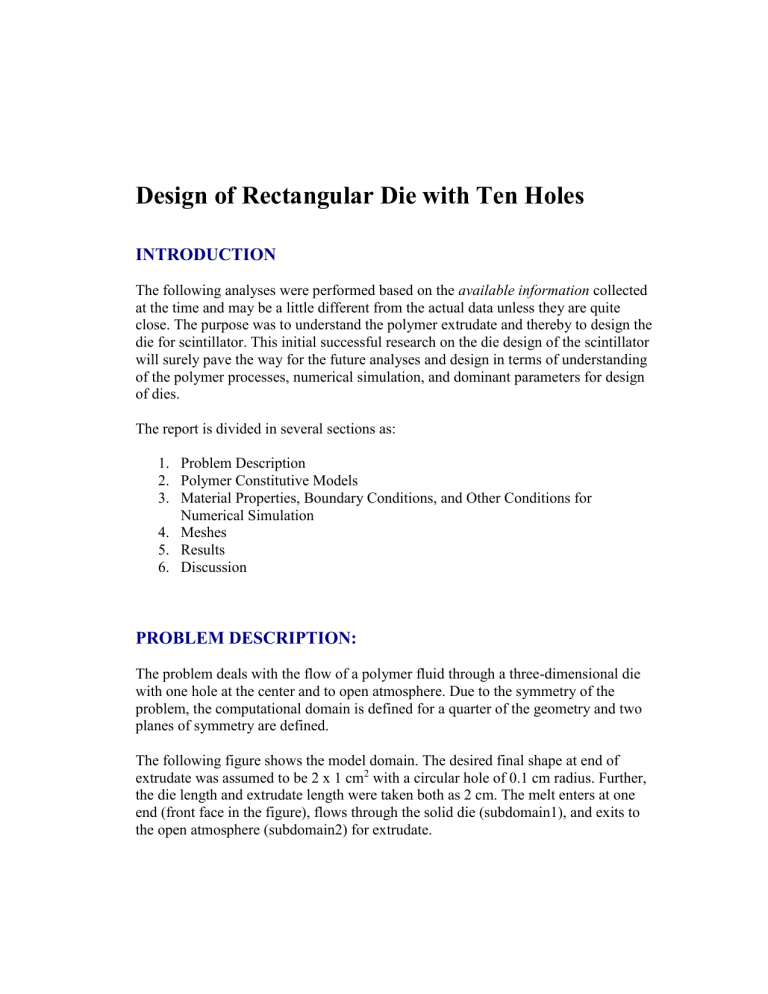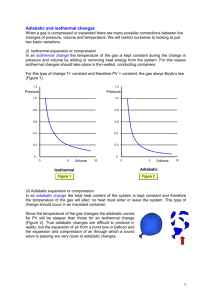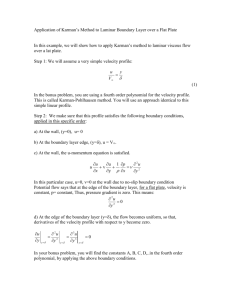Design of Rectangular Die with One Hole for Styron 685d

Design of Rectangular Die with Ten Holes
INTRODUCTION
The following analyses were performed based on the available information collected at the time and may be a little different from the actual data unless they are quite close. The purpose was to understand the polymer extrudate and thereby to design the die for scintillator. This initial successful research on the die design of the scintillator will surely pave the way for the future analyses and design in terms of understanding of the polymer processes, numerical simulation, and dominant parameters for design of dies.
The report is divided in several sections as:
1.
Problem Description
2.
Polymer Constitutive Models
3.
Material Properties, Boundary Conditions, and Other Conditions for
Numerical Simulation
4.
Meshes
5.
Results
6.
Discussion
PROBLEM DESCRIPTION:
The problem deals with the flow of a polymer fluid through a three-dimensional die with one hole at the center and to open atmosphere. Due to the symmetry of the problem, the computational domain is defined for a quarter of the geometry and two planes of symmetry are defined.
The following figure shows the model domain. The desired final shape at end of extrudate was assumed to be 2 x 1 cm
2
with a circular hole of 0.1 cm radius. Further, the die length and extrudate length were taken both as 2 cm. The melt enters at one end (front face in the figure), flows through the solid die (subdomain1), and exits to the open atmosphere (subdomain2) for extrudate.
2
Figure 1.
Model Domain
POLYMER CONSTITUTIVE MODELS
In contrast to Newtonian fluid for which there exists a single constitutive model that can account for all Newtonian flows, there is no single model that can account for all polymer flows due to complexity of the polymer fluid. This leads to many suggested models for different flows. Though some are much more general than some others like co-rotational and co-deformational models, they are too complicated for ordinary implementation. Thus, simple but much practical models are more frequently found being used in industry. One extension of Newtonian model is called generalized
Newtonian model. In this analysis this model is used with in different scenarios; (1) isothermal flow and (2) non-isothermal flow. This model has been used in industry for more than a couple of decades and proved to quite accurately predict the flows in die design as in this study.
Generalized Newtonian Isothermal Flow
Generalized Newtonian Non-Isothermal Flow with Temperature dependence on Viscosity. (Viscous heating is not taken into account).
Even in the generalized Newtonian model there are various models. In this study the
Carreau-Yasoda model was adopted as used in Altair’s report for Fermi Lab.
3
MATERIAL PROPERTIES, BOUNDARY CONDITIONS, AND
OTHER CONDITIONS FOR NUMERICAL SIMULATION
Material properties used in the study are assumed same as in Altair’s report and are of
Dow’s
Styron 685d . This material is chosen because it has all the values necessary to run the POLYFLOW software and is the closest to the Styron 633 provided by Fermi
Lab. It is also expected to yield very similar results to the Styron 633.
MODEL 1. GENERALIZED NEWTONIAN ISOTHERMAL FLOW
MATERIAL DATA
Density
Specific Heat
Thermal Conductivity
Coefficient of Thermal Expansion (
)
882 kg/m
3
1200 J/Kgo
K
0.12307 W/mo K
5 x 10
-5
m/mo
K
Shear-rate Dependent Viscosity (Carreau-Yasoda Law)
(
)
0
1
Zero Shear Rate Viscosity (fac or
e oa
e o e o
)
1 oa
Infinite Shear Rate Viscosity (facinf or
)
Exponent (exp o or e o
)
200,000 Pa-s
0 Pa-s
0.252 (evolution on this parameter)
Time Constant (tnat or
)
Transition Parameter (exp oa or e oa
)
Temperature Dependent Viscosity
BOUNDARY CONDITIONS
4.6337
0.5
No
The boundary sets for the problem are same as the one-hole die design except that there are 10 holes in this case and the conditions at the boundaries of the domains are repeated here with the figure for one-hole case:
boundary 1: flow inlet, volumetric flow rate Q = 7.091 x 10 -7 m 3 /s (i.e., uniform velocity = 1.4041 x 10
-2
m/s) boundary 2: at wall zero velocity, v s
= v n
= 0 boundary 3: at wall zero velocity, v s
= v n
= 0
boundary 4: at symmetry plane zero tangential forces and zero normal velocity, f s
= v n
=0 boundary 5: at symmetry plane zero tangential forces and zero normal velocity, f s
= v n
=0 boundary 6: at free surface moving boundary conditions with atmospheric pressure, p = p boundary 7: at free surface moving boundary conditions with atmospheric pressure, p = p boundary 8: at free surface of flow exit, f s
= f n
= 0
4
BS8
BS2
BS6 BS7
BS3
BS5
BS4 BS1
Figure 2.
Model Boundaries
GLOBAL REMESHING
1 st
Local Remeshing: Remove Subdomain1 to specify the remeshing to be done on Subdomain2. Select OptiMesh3D for the remeshing technique along with line kinematic condition. Specify the inlet for the system of planes as
Intersection with Subdomain1 and the outlet for the system of planes as
Intersection with Boundary8.
Enable the Inverse Prediction Management.
Enable Evolution on moving boundaries
2 nd
Local Remeshing: Add Subdomain1 and select constant section for prediction.
INTERPOLATION
Linear Coordinates.
5
Mini element for linear velocities and constant pressure.
Modify the number of iterations in Numerical parameters to 30. Or use Picard iterative scheme
NUMERICAL PARAMETERS: Modify the evolution parameters
Modify the number of iterations in Numerical parameters to 30. Or Picard iterative scheme is used with evolution scheme on the exponent of the viscosity law. This scheme is used for low values of exponent.
ENABLE IGES file output:
MANAGE probes:
SAVE and exit from the Polydata and Run the Polyflow program:
MODEL 2. GENERALIZED NEWTONIAN NON-ISOTHERMAL FLOW
MATERIAL DATA
In addition to the data given for isothermal flow, the following data are also used:
Temperature Dependent Viscosity (Arrhenious Approximate law) h ( T )
e
( T
T )
Density :(Here, the Boussinesq approximation is used instead of a constant density. This model treats density as a constant value in all solved equations, except for the buoyancy term in the momentum equation)
Material Constant (alfa or
)
Reference Temperature (talfa or T )
Coefficient of Thermal Expansion (beta or
)
0.0603919
453 o
K
5 x 10
-5
m/mo
K
300K Reference Temperature (tbeta or T )
Thermal Conductivity (condu or k) k ( T )
a
b ( T
T
0
)
c ( T
T
0
)
2 where a = 0.12307 W/mo K d ( T
T
0
)
3
6
Heat Capacity per Unit Mass
C p
( T )
a
b ( T
T
0
)
c ( T
T
0
)
2 d ( T where a = 1200 J/Kgo
K
Viscous Heating
T
0
)
3
Not taken into account
Average Temperature (tinit or T init
) 466K (constant)
Note: The closer this temperature is to the solution, the better the convergence will be. If this temperature is too far from the solution, the numerical scheme might diverge.
BOUNDARY CONDITIONS
In addition to the boundary sets for the isothermal flow the following boundary conditions are also used.
Thermal Boundary Conditions:
Temperature imposed along the inlet and the walls of the die: 466 o
K
Flux density is imposed on the free surfaces as convection boundaries. The condition is as follows: q
q c
( T
T
)
[( T
T
0
)
4
( T
T
0
)
4 where
=
5.7 W/m
2
o
K and T = 300 o
K
Outflow condition is selected at the outlet for a vanishing conductive heat flux.
GLOBAL REMESHING
Same as the isothermal case.
INTERPOLATION
The mini-element method is recommended for most 3D flows, since it provides reasonably accurate results at lower cost than the quadratic methods. In the
Interpolation menu in POLYDATA , the mini-element option corresponds to the
Mini-element for velocities, constant pressure menu item.
The major drawback of the mini-element is its low-pressure accuracy due to the piecewise-constant finite-element pressure representation. This can cause problems for some meshes that exhibit a large aspect ratio (i.e., meshes for which the dimension in one direction is much smaller than in another direction, so that a strong pressure gradient develops). The problem becomes worse if the mesh
includes elements that are strongly deformed (i.e., elements whose opposite sides are of different dimensions).
7
In order to address this problem without imposing the use of the CPU-intensive quadratic approximation (described below), a combination of the mini-element with a linear pressure is provided. In the Interpolation menu in POLYDATA , the mini-element with linear pressure option corresponds to the Mini-element for velocities, linear pressure menu item. This option greatly improves the pressure representation in cases where the accuracy of the standard mini-element is not good. Note that the mini-element with linear pressure uses ``bubble'' velocity shape functions at element centers. However, even with this additional bubble shape function at the element centers, there are rare boundary condition cases where the element violates incompressibility conditions. In order to avoid solution difficulties, the incompressibility equation is stabilized with an artificial compressibility that is small enough to not be a problem in practical flow situations.
The quadratic-linear representation ( Quadratic velocities, linear pressure ) is the most accurate and the most expensive of all representations, and the quadraticlinear-discontinuous representation ( Quadratic velocities, linear discontinuous pressure ) may be more accurate for free surface or thermal convection problems.
However, using the quadratic representation on a dense 3D finite-element mesh can be computationally expensive and require a significant amount of memory.
For non-isothermal flows, several types of interpolation are available in
POLYFLOW to calculate the temperature field. You should select the interpolation type according to the Péclet number: P e
c k p vL
where v is characteristic velocity of the flow, and L is characteristic length of the flow. For moderate Péclet numbers, subdivision into 2
2 linear sub-elements with a
Galerkin method is recommended for the energy equation. In the Interpolation menu in POLYDATA , this option corresponds to the 2
2 element for temperature menu item. For flows with high Péclet numbers, you should use
4
4 sub-elements with a streamline-upwind Petrov-Galerkin method for the energy equation. In the Interpolation menu in POLYDATA , this option corresponds to the 4x4 element for temperature menu item.
This method refines the mesh for temperature without increasing the cost of the velocity-pressure calculation. Note, however, that the 4x4 element for temperature is not available for 3D simulations. For high-Péclet-number 3D cases, the 2x2 element for temperature is recommended instead.
Linear coordinates (the default) are recommended for flows that do not involve surface tension.
NUMERICAL PARAMETERS: Modify the evolution parameters
Modify the number of iterations in Numerical parameters to 30. Or Picard iterative scheme is used with evolution scheme on the exponent of the viscosity law. This scheme is used for low values of exponent.
ENABLE IGES file output:
MANAGE probes:
SAVE and exit from the Polydata and Run the Polyflow program:
MODEL 3. GENERALIZED NEWTONIAN NON-ISOTHERMAL FLOW
INCLUDING VISCOUS HEATING
Here, the change from the above steps is nothing but to take into account viscous heating in the MATERIAL DATA menu.
MESHES
For each model, the following mesh is used.
8
(a)
(b)
9
(c)
Figure 3.
(a) Quarter domain mesh used in analyses, (b) full domain mesh, and (c) close-up mesh
RESULTS
The general behaviors of the pressure, velocity, viscosity, and shear rate distributions are similar for both flows and are shown below for isothermal flow.
In the following detailed results are shown for the case of isothermal flow followed by comparison between two flows.
ISOTHERMAL FLOW
Figure 4.
Pressure Contours in Isothermal Flow
Figure 5.
Velocity Contours in Isothermal Flow
10
Figure 6.
Velocity Surfaces along Z-direction (Isothermal flow)
Figure 7.
Viscosity Contours (Isothermal flow)
11
Figure 8.
Shear rate Contours (Isothermal flow)
(a)
12
13
(b)
Figure 9.
(a) Swelling of the Extrudate (Isothermal flow) and (b) closeup view around the center
Figure 10.
Domain of the Die lip at the Inlet (Isothermal)
NON-ISOTHERMAL FLOW (NO VISCOUS HEATING)
14
Figure 11.
Pressure Contours in Non-Isothermal Flow
(a)
(b)
(c)
Figure 12.
(a) Velocity Contours in Non-Isothermal Flow, (b) same contours with change of ranges of velocity magnitude, (c) close-up view around the max. velocity
15
Figure 13.
Velocity Surfaces along Z-direction (Non-Isothermal flow)
Figure 14.
Viscosity Contours (Non-Isothermal flow)
16
Figure 15.
Shear rate Contours (Non-Isothermal Flow)
Figure 16.
Temperature Contours (Non-Isothermal Flow)
17
(a)
(b)
18
19
(c)
Figure 17.
(a) Swelling of the Extrudate (Non-Isothermal flow), (b) closeup view near the wall, and (c) close-up view near the center
Figure 18.
Domain of the Die-lip at the inlet (Non-Isothermal Flow)
COMPARISON OF DIE LIP SHAPES FOR DIFFERENT MODELS
20
Figure 19.
Comparison of Die Inlet lip for Isothermal and Non-Isothermal
COMPARISON OF VELOCITY PROFILES AT DIFFERENT SECTIONS
Figure 20.
Velocity profile at the Outlet of the die (Isothermal condition).
21
Figure 21.
Velocity profile at the outlet of the die (Non Isothermal condition).
Figure 22.
Velocity profile at the inlet of the die (z = 0).
22
Figure 23.
Velocity profile at z = 0.005m of the die.
Figure 24.
Velocity profile at z = 0.01m of the die.
23
DISCUSSION
The results from two different models suggest that both iso- and non-isothernal flows produce very close die shapes.






